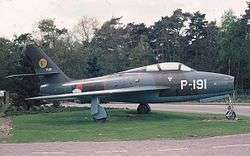Republic F-84F Thunderstreak
| F-84F Thunderstreak RF-84F Thunderflash | |
|---|---|
 | |
| USAF F-84F Thunderstreak | |
| Role | Fighter-bomber/Reconnaissance aircraft |
| Manufacturer | Republic Aviation |
| First flight | June 3, 1950 |
| Introduction | May 12, 1954 |
| Retired | 1972 (US ANG) 1991 (Greece) |
| Primary users | United States Air Force Belgian Air Force German Air Force Royal Netherlands Air Force |
| Number built | 3,428 |
| Unit cost |
US$769,330 (F-84F) |
| Developed from | Republic F-84 Thunderjet |
| Variants | Republic XF-84H Thunderscreech |
The Republic F-84F Thunderstreak was an American-built swept-wing turbojet fighter-bomber. While an evolutionary development of the straight-wing F-84 Thunderjet, the F-84F was a new design. The RF-84F Thunderflash was an photo reconnaissance version.
Development
In 1949, a swept wing version of the F-84 was created with the hope of bringing performance to the level of the F-86. The last production F-84E was fitted with a swept tail, a new wing with 38.5 degrees of leading edge sweep and 3.5 degrees of anhedral, and a J35-A-25 engine producing 5,300 pound-force (23.58 kN) of thrust.[1] The aircraft was designated XF-96A. It flew on 3 June 1950 with Otto P. Haas at the controls. Although the airplane was capable of 602 knots (693 mph, 1,115 km/h), the performance gain over the F-84E was considered minor.[1] Nonetheless, it was ordered into production in July 1950 as the F-84F Thunderstreak. The F-84 designation was retained because the fighter was expected to be a low-cost improvement of the straight-wing Thunderjet with over 55 percent commonality in tooling.[1]
In the meantime, the USAF, hoping for improved high-altitude performance from a more powerful engine, arranged for the British Armstrong Siddeley Sapphire turbojet engine to be built in the United States as the Wright J65. To accommodate the larger engine, YF-84Fs with a British-built Sapphire as well as production F-84Fs with the J65 had a vertically stretched fuselage, with the air intake attaining an oval cross-section. Production delays with the F-84F forced the USAF to order a number of straight-wing F-84Gs as an interim measure.[1]
Production quickly ran into problems. Although tooling commonality with the Thunderjet was supposed to be 55 percent, in reality only fifteen percent of tools could be reused.[1] To make matters worse, the F-84F utilized press-forged wing spars and ribs. At the time, only three presses in the United States could manufacture these, and priority was given to the Boeing B-47 Stratojet bomber over the F-84.[1] The YJ65-W-1 engine was considered obsolete and the improved J65-W-3 did not become available until 1954. When the first production F-84F finally flew on 22 November 1952, it differed from the service test aircraft. It had a different canopy which opened up and back instead of sliding to the rear, as well as airbrakes on the sides of the fuselage instead of the bottom of the aircraft.[1] The aircraft was considered not ready for operational deployment due to control and stability problems. The first 275 aircraft, equipped with conventional stabilizer-elevator tailplanes, suffered from accelerated stall pitch-up and poor turning ability at combat speeds. Beginning with Block 25, the problem was ameliorated by the introduction of a hydraulically powered one-piece stabilator. A number of aircraft were also retrofitted with spoilers for improved high-speed control. As a result, the F-84F was not declared operational until 12 May 1954.[1]
Thunderflash

The second YF-84F prototype was completed with wing-root air intakes. These were not adopted for the fighter due to loss of thrust. However, this arrangement permitted placement of cameras in the nose and the design was adopted for the RF-84F Thunderflash reconnaissance version. The first YRF-84F was completed in February 1952.[1] The aircraft retained an armament of four machine guns and could carry up to fifteen cameras. Innovations included computerized controls which adjusted camera settings for light, speed, and altitude, a periscope to give the pilot better visualization of the target, and a voice recorder to let the pilot narrate his observations. Being largely identical to the F-84F, the Thunderflash suffered from the same production delays and engine problems, delaying operational service until March 1954. The aircraft was retired from active duty in 1957, only to be reactivated in 1961, and finally retired from the ANG in 1972.[1]
Several modified Thunderflashes were used in the FICON project.
Design
The Thunderstreak suffered from the same poor takeoff performance as the straight-wing Thunderjet despite having a more powerful engine. In reality, almost 700 pounds-force (3.11 kN) or ten percent of total thrust was lost because the J65 was installed at an angle and its exhaust had a prominent kink. On a hot day, 7,500 feet (2,285 m) of runway were required for takeoff roll.[2] A typical takeoff speed was 160 knots (185 mph, 300 km/h).[2] Like the Thunderjet, the Thunderstreak excelled at cruise and had predictable handling characteristics within its performance envelope. Like its predecessor, it also suffered from accelerated stall pitch-up and potential resulting separation of wings from the airplane. In addition, spins in the F-84F were practically unrecoverable and ejection was the only recourse below 10,000 feet (3,000 m).[2]
Operational history


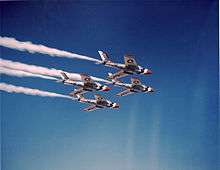

Project Run In completed operational tests in November 1954 and found the aircraft to be to USAF satisfaction and considerably better than the F-84G. However, ongoing engine failures resulted in the entire fleet being grounded in early 1955. Also, the J65 engine continued to suffer from flameouts when flying through heavy rain or snow.[1] As the result of the problems, the active duty phaseout began almost as soon as the F-84F entered service in 1954, and was completed by 1958. Increased tensions in Germany associated with construction of the Berlin Wall in 1961 resulted in reactivation of the F-84F fleet. In 1962, the fleet was grounded due to the corrosion of control rods. A total of 1,800 man hours were expended to bring each aircraft to full operational capacity.[1] Stress corrosion eventually forced the retirement of ANG F-84Fs in 1971.
On 9 March 1955, Lt. Col. Robert R. Scott, in a F-84F Thunderstreak, set a three-hour, 44-minute and 53-second record for the 2,446 mile flight from Los Angeles to New York.[3]
With the appearance of the Republic F-105 Thunderchief, which also used wing-root mounted air intakes, the Thunderstreak became known as the Thud's Mother.[2] The earlier F-84A had been nicknamed the "Hog" and the F-84F "Super Hog," the F-105 becoming the "Ultra Hog".
In what is probably one of the very few air-to-air engagements involving the F-84F, two Turkish Air Force F-84F Thunderstreaks shot down two Iraqi Il-28 Beagle bombers that crossed the Turkish border by mistake during a bombing operation against Iraqi Kurdish insurgents. This engagement took place on 16 August 1962.[4]
The F-84F was retired from active service in 1964, and replaced by the North American F-100 Super Sabre. The RF-84F was replaced by the RF-101 Voodoo in USAF units, and relegated to duty in the Air National Guard. The last F-84F Thunderflash retired from the ANG in 1971. Three Hellenic Air Force RF-84Fs that were retired in 1991 were the last operational F-84s.
Variants

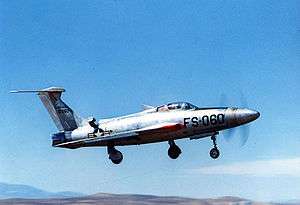

- YF-84F
- Two swept-wing prototypes of the F-84F, initially designated YF-96.
- F-84F Thunderstreak
- Swept wing version with Wright J65 engine. Tactical Air Command aircraft were equipped with Low-Altitude Bombing System (LABS) for delivering nuclear bombs. 2,711 built, 1,301 went to NATO under Mutual Defense Assistance Program (MDAP).
- GRF-84F
- 25 RF-84Fs were converted to be carried, and launched from the bomb bay of a GRB-36F bomber as part of the FICON project. The aircraft were later redesignated RF-84K.
- RF-84F Thunderflash
- Reconnaissance version of the F-84F, 715 built.
- RF-84K Thunderflash (FICON)
- RF-84F with a retractable probe for hookup with carrier GRB-36Ds and tailplanes with marked anhedral, 25 redesignated from RF-84F.[5]
- XF-84H
- Two F-84Fs were converted into experimental aircraft. Each was fitted with an Allison XT40-A-1 turboprop engine of 5,850 shaft horsepower (4,365 kW) driving a supersonic propeller. Ground crews dubbed the XF-84H the Thunderscreech due to its extreme noise output.[1]
- YF-84J
- Two F-84Fs were converted into YF-84J prototypes with enlarged nose intakes and a deepened fuselages for the General Electric J73 engine; the YF-84J reached Mach 1.09 in level flight on 7 April 1954.[1] The project was cancelled due to the excessive cost of converting existant F-84Fs.
Operators


- Belgian Air Force (197 x F-84F, 34 x RF-84F operated from 1955)
- Royal Danish Air Force (23× RF-84F 1957–1971) [6]
- West German Air Force (450× F-84F, 108× RF-84F 1956–1967)
- Italian Air Force operated 194 Republic F-84F Thunderstreak and 78 RF-84F Thunderflash from 1956 until 1974[7][8]
- Royal Netherlands Air Force (180× F-84F, 24× RF-84F 1955–1970)
- Royal Norwegian Air Force (35× RF-84F 1956–1970)
- United States Air Force (1496× F-84F, 388× RF-84F 1952–1972)
Aircraft on display
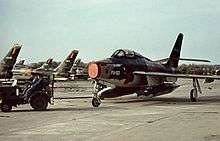
Belgium
- Unknown – Balen-Keiheuvel Aerodrome [9]
- Unknown – Beverlo Air Base [10]
Italy
- F-84F
- 53-6892 – Italian Air Force Museum, Vigna di Valle near Rome.
- RF-84F Thunderflash
- 52-7458 – Italian Air Force Museum, Vigna di Valle near Rome.
Netherlands
- F-84F
- 53-6612 - Nationaal Militair Museum, Soesterberg. [11]
Norway
- RF-84F Thunderflash
- 51-7055 – Under restoration to original bare aluminium scheme, Air Force Training Center, Kjevik.
- 51-17045 – Flyhistorisk Museum, Sola, Stavanger Airport, Sola, near Stavanger.[12]
- 51-17053 – Forsvarets flysamling Gardermoen, Oslo Airport, Gardermoen near Oslo.[13]
Poland
- F-84F
- 52-7157 (Ex-Belgium) – Polish Aviation Museum, Kraków.[14]
Russia
- F-84F
- ?-3033 (Ex-Belgium) – Technical Museum, Moscow.
Turkey
- F-84F
- 51-1901 – Istanbul Aviation Museum.[15]
- 52-8733 – Istanbul Aviation Museum.[15]
- 52-8941 – Atatürk Airport, İstanbul.[16]
United Kingdom
- F-84F
- 52-6541 – North East Aircraft Museum, Sunderland.[17]
United States
- XF-84F
- F-84F
.jpg)
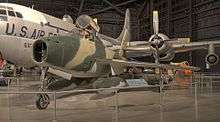
- Unknown – On roadside display (private owner) in Blacksville, West Virginia.[19]
- 51-1386 – Barksdale Global Power Museum, Barksdale AFB, Louisiana.[20]
- 51-1620 – Empire State Aerosciences Museum in Glenville, New York.[21]
- 51-1639 – Springfield Downtown Airport, Springfield, Missouri.[22]
- 51-1640 – Hill Aerospace Museum, Hill AFB, Utah.[23]
- 51-1713 – Delta County Airport in Escanaba, Michigan.[24]
- 51-1714 – Strategic Air Command & Aerospace Museum in Ashland, Nebraska.[25]
- 51-1739 – Korean War memorial South Whitley, Indiana.[26]
- 51-1772 – Aerospace Museum of California in McClellan, California.[27]
- 51-1786 – Virginia Air & Space Center in Hampton, Virginia.[28]
- 51-1797 – Ohio ANG Base in Springfield, Ohio.[29]
- 51-1817 – Camp Robinson in Little Rock, Arkansas.[30]
- 51-1818 – Fairfield MAP in Iowa.[31]
- 51-1822 – Illinois ANG Base in Springfield, Illinois.[32]
- 51-9350 – Air Force Flight Test Center Museum at Edwards AFB, California.[33]
- 51-9396 – Holloman AFB, New Mexico.[34]
- 51-9430 – Joint Base McGuire-Dix-Lakehurst, New Jersey. False markings of 52-7066 applied.[35]
- 51-9432 – March Field Air Museum in Riverside, California.[36]
- 51-9433 – Castle Air Museum in Atwater, California.[37]
- 51-9444 – Seminole Valley Park in Cedar Rapids, Iowa.[38]
- 51-9451 – Wilson Park in Granite City, IL.[39]
- 51-9480 – American Airpower Museum, East Farmingdale, New York.[40]
- 51-9495 – Air Force Armament Museum, Eglin AFB, Florida.[41]
- 51-9501 – Yankee Air Museum, Belleville, Michigan.[42]
- 51-9514 – Allen County War Memorial Coliseum in Ft. Wayne, Indiana.[43]
- 51-9531 – Chanute Air Museum in Rantoul, Illinois.[44]
- 52-6438 – Georgia Veterans State Park in Cordele, Georgia.[45]
- 52-6455 – American Legion post #490, Houston, Texas.[46]
- 52-6456 – Veterans of Foreign Wars post #6791, West Chicago, Illinois.[47]
- 52-6461 – Lackland AFB, Texas.[48]
- 52-6470 – Mountain Home AFB, Idaho.[49]
- 52-6497 – Iowa Gold Star Museum in Johnston, Iowa.[50]
- 52-6526 – National Museum of the United States Air Force in Dayton, Ohio.[51]
- 52-6553 – Window on the Plains Museum in Dumas, Texas.[52]
- 52-6555 – Wings of Freedom Aviation Museum in Horsham, Pennsylvania.
- 52-6563 – Pima Air & Space Museum in Tucson, Arizona.[53]
- 52-6634 – Defense Supply Center Richmond in Richmond, Virginia.[54]
- 52-6701 – Museum of Aviation, Robins AFB, Georgia.[55]
- 52-6782 – Luke AFB, Arizona.[56]
- 52-6993 – Wilbur Wright Birthplace and Museum near Millville, Indiana.[57]
- 52-7019 – Cheyenne Municipal Airport in Wyoming.[58]
- 52-7080 – England AFB, Louisiana.[59]
- 52-8837 – Richmond Airport, Virginia.[60]
- 52-8886 – South Dakota Air and Space Museum at Ellsworth AFB, South Dakota.[61]
- RF-84F Thunderflash
- 51-1944 – Pima Air & Space Museum in Tucson, Arizona.[62]
- 51-11259 – Lincoln Air National Guard Base, Nebraska.[63]
- 52-7249 – Dannelly Field ANG Collection, Montgomery, Alabama.[64]
- 52-7259 – National Museum of the United States Air Force in Dayton, Ohio.[65]
- 52-7265 – Planes of Fame Museum in Chino, California.[66]
- 52-7409 – Birmingham ANGB, Birmingham, Alabama.[67]
- 52-7421 – Yankee Air Museum, Belleville, Michigan.[68]
- 53-7595 – American Airpower Museum, East Farmingdale, New York.[69]
Accidents and incidents
- On 4 April 1957, the USAF Captain Richard W. Higgins died after a low ejection with one of the first F-84Fs of the German Air Force near the Fürstenfeldbruck Air Base.
- In June 1957 Bud Day survived a "no chute" ejection from an F-84 in Britain following an engine fire.[70]
- On 29 August 1961, a French Air Force F-84F clipped the cable of an aerial tramway at Mont Blanc, killing six people and leaving 81 more stranded. The pilot was on a reconnaissance mission and was unaware of the accident until after he had landed.[71]
- On 14 September 1961, two West German F-84Fs of the West German Air Force crossed into East German airspace due to a navigational error, eventually landing at Berlin Tegel Airport, evading a large number of Soviet fighter aircraft. The event came at a historically difficult time during the Cold War, one month after the construction of the Berlin Wall.[72]
- July 29, 1966 crash in South Gardner, MA
Specifications (F-84F)
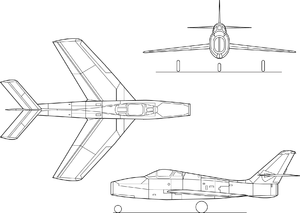
Data from Fighters of the United States Air Force,[73] Combat Aircraft since 1945[74]
General characteristics
- Crew: 1
- Length: 43 ft 4¾ in (13.23 m)
- Wingspan: 33 ft 7¼ in (10.25 m)
- Height: 14 ft 4¾ in (4.39 m)
- Wing area: 325 ft² (30 m²)
- Empty weight: 13,830lb (5,200 kg)
- Loaded weight: lb (kg)
- Max. takeoff weight: 28,000 lb (12,701 kg)
- Powerplant: 1 × Wright J65-W-3 turbojet, 7,220 lbf (32.2 kN)
Performance
- Maximum speed: 695 mph (604 knots, 1,119 km/h, Mach .91) at sea level
- Range: 810 mi (704 nmi, 1,304 km) combat radius with two droptanks
- Service ceiling: 46,000 ft (14,000 m)
- Rate of climb: 8,200 ft/min (42 m/s)
- Wing loading: 86 lb/ft² (423 kg/m²)
Armament
- 6× .50 in (12.7 mm) Browning M3 machine guns,
- Up to 6,000lb (2,727 kg) of rockets and bombs, including one Mark 7 nuclear bomb
Avionics
- A-1CM or A-4 gunsight with APG-30 or MK-18 ranging radar
Communications Equipment
- AN/ARC-33 or 34 command set radio
- AN/APX-6 or 6A IFF set
- AN/AR-6 radio compass
- AN/APW-11 or 11A radar set
- AN/APN-21 TACAN set
Notable appearances in media
Richard Bach, who later wrote the bestseller Jonathan Livingston Seagull, was an ANG F-84F pilot who was once activated for duty in Europe. His first book, Stranger to the Ground, described in detail what it was like to fly the Thunderstreak in the course of an operational flight at night from England to France in adverse weather.
F-84Fs were also used to represent North Korean MIG-15 fighters in the 1958 film version of James Salters' novel "The Hunters", because none of the Soviet fighters were available during the ongoing Cold War for filming. They were painted a flat gray with red star insignia.
See also
- Related development
- Republic F-84 Thunderjet
- Republic F-105 Thunderchief
- Republic XF-84H Thunderscreech
- Republic XF-91 Thunderceptor
- RF-84K FICON
- Aircraft of comparable role, configuration and era
References
Notes
- 1 2 3 4 5 6 7 8 9 10 11 12 13 14 Knaack 1978, p. 42.
- 1 2 3 4 Higham, Robin and Carol Williams. Flying Combat Aircraft of USAAF-USAF (Vol.2). Rockville, Maryland: Air Force Historical Foundation, 1978. ISBN 0-8138-0375-6.
- ↑ "Week In History". U.S. Air Force. Archived from the original on 23 July 2012. Retrieved 4 March 2013.
- ↑ Cooper, Tom. "Europe & Cold War Database: Cyprus, 1955–1973." Air Combat Information Group, 26 October 2003. Retrieved: 8 September 2009.
- ↑ Knaack, Marcelle Size (1988). Encyclopedia of US Air Force Aircraft and Missile Systems. Vol. 2, Post-World War II Bombers 1945–1973. Washington, DC: Office of Air Force History. pp. 38–39. ISBN 0-912799-59-5.
- ↑ Schrøder, Hans (1991). "Royal Danish Airforce". Ed. Kay S. Nielsen. Tøjhusmuseet, 1991, p. 62. ISBN 87-89022-24-6.
- ↑ "Italian Air Force Aircraft Types". www.aeroflight.co.uk.
- ↑ "Republic F-84F Thunderstreak" Aeronautica Militare
- ↑ "Republic F-84F Thundertreak FU-197 – Hangar Flying". www.luchtvaarterfgoed.be.
- ↑ "Poortwachter Thunderstreak FU177 – Hangar Flying". www.luchtvaarterfgoed.be.
- ↑ "Jachtbommenwerper Republic F-84F 'Thunderstreak' registratienummer P-226".
- ↑ "RF-84F Thunderflash/51-17045." aerialvisuals.ca Retrieved: 7 April 2015.
- ↑ "RF-84F Thunderflash/51-17053." aerialvisuals.ca Retrieved: 7 April 2015.
- ↑ "F-84 Thunderstreak/52-7157." skrzydla.org. Retrieved: 7 May 2013.
- 1 2 http://www.tayyareci.com/digerucaklar/turkiye/1951ve2006/rf84.asp
- ↑ "Republic F-84F Thunderstreak Aviation Photos – Planespotters.net Just Aviation". www.planespotters.net.
- ↑ "F-84 Thunderstreak/52-6541." North East Aircraft Museum. Retrieved: 7 May 2013.
- ↑ "F-84 Thunderstreak/49-2430." National Museum of the USAF. Retrieved: 16 July 2017.
- ↑ "F-84 Thunderstreak/unknown." flickr.com. Retrieved: 17 June 2013.
- ↑ "F-84 Thunderstreak/51-1386." 8th Air Force Museum. Retrieved: 14 January 2015.
- ↑ "F-84 Thunderstreak/51-1620." Empire State Aeorsciences Museum. Retrieved: 14 Jan 2015.
- ↑ "F-84 Thunderstreak/51-1639." aerialvisuals.ca Retrieved: 12 January 2015.
- ↑ "F-84 Thunderstreak/51-1640." Hill Aerospace Museum. Retrieved: 11 October 2012.
- ↑ "F-84 Thunderstreak/51-1713." aerialvisuals.ca Retrieved: 12 January 2015.
- ↑ "F-84 Thunderstreak/51-1714." Strategic Air & Space Museum. Retrieved: 14 January 2015.
- ↑ "F-84 Thunderstreak/51-1739." coastcomp.com
- ↑ "F-84 Thunderstreak/51-1772." Aerospace Space Museum of California. Retrieved: 14 January 2015.
- ↑ "F-84 Thunderstreak/51-1786." Virginia Air & Space Center. Retrieved: 14 January 2015.
- ↑ "F-84 Thunderstreak/51-1797." aerialvisuals.ca Retrieved: 7 April 2015.
- ↑ "F-84 Thunderstreak/51-1817." aerialvisuals.ca Retrieved: 7 April 2015.
- ↑ "F-84 Thunderstreak/51-1818." aerialvisuals.ca Retrieved: 7 April 2015.
- ↑ "F-84 Thunderstreak/51-1822." aerialvisuals.ca Retrieved: 7 April 2015.
- ↑ "F-84 Thunderstreak/51-9350." Air Force Flight Test Center Museum. Retrieved: 7 April 2015.
- ↑ "F-84 Thunderstreak/51-9396." aerialvisuals.ca Retrieved: 7 April 2015.
- ↑ "F-84 Thunderstreak/51-9430." aerialvusuals.ca Retrieved: 12 January 2015.
- ↑ "F-84 Thunderstreak/51-9432." March Field Air Museum. Retrieved: 14 January 2015.
- ↑ "F-84 Thunderstreak/51-9433." Castle Air Museum. Retrieved: 14 January 2015.
- ↑ "F-84 Thunderstreak/51-9444." aerialvisuals.ca Retrieved: 7 April 2015.
- ↑ "F-84 Thunderstreak/51-9451." aerialvisuals.ca Retrieved: 14 January 2015.
- ↑ "F-84 Thunderstreak/51-9480." aerialvisuals.ca Retrieved: 4 April 2016.
- ↑ "F-84 Thunderstreak/51-9495." Air Force Armament Museum. Retrieved: 11 October 2012.
- ↑ "F-84 Thunderstreak/51-9501." Yankee Air Museum. Retrieved: 14 January 2015.
- ↑ "F-84 Thunderstreak/51-9514." aerialvisuals.ca Retrieved: 7 April 2015.
- ↑ "F-84 Thunderstreak/51-9531." Chanute Air Museum. Retrieved: 14 January 2015.
- ↑ "F-84 Thunderstreak/52-6438." aerialvisuals.ca Retrieved: 7 April 2015.
- ↑ "Our F-84F" ' Retrieved: 28 March 2017.
- ↑ "F-84 Thunderstreak/52-6456." aerialvisuals.ca Retrieved: 7 April 2015.
- ↑ "F-84 Thunderstreak/52-6461." aerialvisuals.ca Retrieved: 7 April 2015.
- ↑ "F-84 Thunderstreak/52-6470." aerialvisuals.ca Retrieved: 7 April 2015.
- ↑ "F-84 Thunderstreak/52-6497." aerialvisuals.ca Retrieved: 7 April 2015.
- ↑ "F-84 Thunderstreak/52-6526." National Museum of the USAF. Retrieved: 16 July 2017.
- ↑ "F-84 Thunderstreak/52-6553." Window on the Plains Museum Retrieved: 12 January 2015.
- ↑ "F-84 Thunderstreak/52-6563." Pima Air & Space Museum. Retrieved: 14 January 2015.
- ↑ "F-84 Thunderstreak/52-6634." aerialvisuals.ca Retrieved: 7 April 2015.
- ↑ "F-84 Thunderstreak/52-6701." Museum of Aviation. Retrieved: 11 October 2012.
- ↑ "F-84 Thunderstreak/52-6782." aerialvisuals.ca Retrieved: 7 April 2015.
- ↑ "F-84 Thunderstreak/52-6993." aerialvisuals.ca Retrieved: 13 May 2016.
- ↑ "F-84 Thunderstreak/52-7019." aerialvisuals.ca Retrieved: 7 April 2015.
- ↑ "F-84 Thunderstreak/52-7080." aerialvisuals.ca Retrieved: 7 April 2015.
- ↑ "F-84 Thunderstreak/52-8837." aerialvisuals.ca Retrieved: 7 April 2015.
- ↑ "F-84 Thunderstreak/52-8886." South Dakota Air and Space Museum. Retrieved: 7 April 2015.
- ↑ "RF-84 Thunderflash/51-1944." Pima Air and Space Museum. Retrieved: 14 January 2015.
- ↑ "RF-84 Thunderflash/51-11259." aerialvisuals.ca Retrieved: 12 January 2015.
- ↑ "RF-84 Thunderflash/52-7249." aerialvisuals.ca Retrieved: 7 April 2015.
- ↑ "RF-84 Thunderflash/52-7259." National Museum of the USAF. Retrieved: 16 July 2017.
- ↑ "RF-84 Thunderflash/52-7265." Planes of Fame Museum. Retrieved: 11 October 2012.
- ↑ "RF-84 Thunderflash/52-7409." aerialvisuals.ca Retrieved: 7 April 2015.
- ↑ "RF-84 Thunderflash/52-7421." Yankee Air Museum. Retrieved: 14 January 2015.
- ↑ "RF-84 Thunderflash/53-7595." aerialvisuals.ca Retrieved: 4 April 2016.
- ↑ "Col. George "Bud" Day Siouxland's Hometown Hero." msn.com. Retrieved: 28 October 2012.
- ↑ "Alpine Rescue Ends Terror." Spokane Daily Chronicle, 30 August 1961, p. 6.
- ↑ "Strauss-Befehl: Bier-Order 61"(in German). Der Spiegel, 9 May 1962. Retrieved: 30 November 2010.
- ↑ Dorr and Donald 1990, p. 134.
- ↑ Wilson 2000, p. 119.
Bibliography
- Bowers, Peter M. and Enzo Angellucci. The American Fighter. New York: Orion Books, 1987. ISBN 0-517-56588-9.
- Donald, David and Lake, Jon, eds. Encyclopedia of World Military Aircraft. London: AIRtime Publishing, 1996. ISBN 1-880588-24-2.
- Dorr, Robert F. and David Donald. Fighters of the United States Air Force. London: Temple Press Aerospace, 1990. ISBN 0-600-55094-X.
- Forrer, Frits T. The Fun of Flying. Gulf Breeze, Florida: Holland's Glory, 1992. ISBN 0-9714490-3-1.
- Hiltermann, Gijs. "Republic F-84F Thunderstreak." Vliegend in Nederland 1 (in Dutch). Eindhoven, Netherlands: Flash Aviation, 1988. ISBN 978-90-71553-04-2.
- Keaveney, Kevin. Republic F-84/Swept-Wing Variants (Aerofax Minigraph, No 15). London: Aerofax, 1987. ISBN 0-942548-20-5.
- Knaack, Marcelle Size (1988). Encyclopedia of US Air Force Aircraft and Missile Systems. Vol. 2, Post-World War II Bombers 1945–1973. Washington, DC: Office of Air Force History. pp. 38–39. ISBN 0-912799-59-5.
- Knaack, Marcelle Size. Encyclopedia of US Air Force Aircraft and Missile Systems: Volume 1 Post-World War II Fighters 1945–1973. Washington, DC: Office of Air Force History, 1978. ISBN 0-912799-59-5.
- Swanborough, Gordon and Peter M. Bowers. United States Military Aircraft Since 1909. Washington, DC: Smithsonian, 1989. ISBN 0-87474-880-1.
- United States Air Force Museum Guidebook. Wright-Patterson AFB, Dayton, Ohio: Air Force Museum Foundation, 1975.
- Wagner, Ray. American Combat Planes, Third Enlarged Edition. New York: Doubleday, 1982. ISBN 0-385-13120-8.
- Wilson, Stewart. Combat Aircraft since 1945. Fyshwick, Australia: Aerospace Publications, 2000. ISBN 1-875671-50-1.
- Pretat, Samuel. "Republic F-84F Thunderstreak & RF-84F Thunderflash." "Republic F-84F Thunderstreak & RF-84F Thunderflash." Editions Minimonde76, 2006.
External links
| Wikimedia Commons has media related to F-84F Thunderstreak. |
